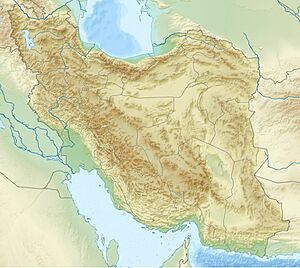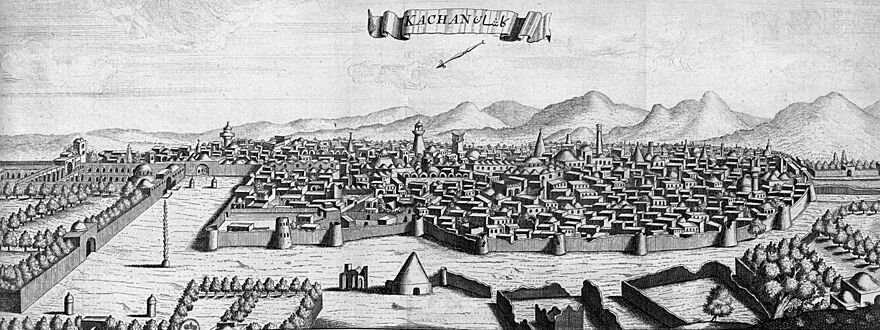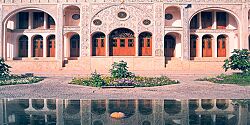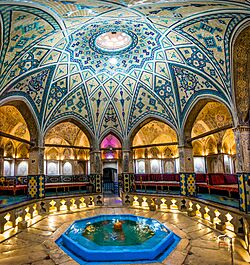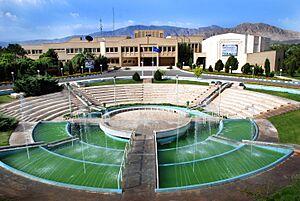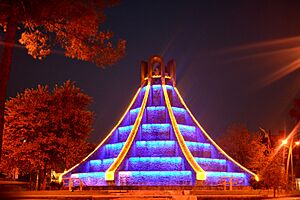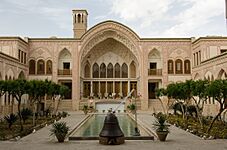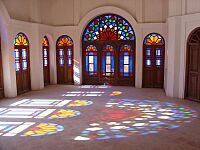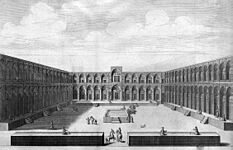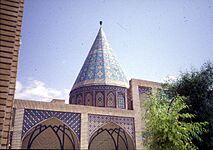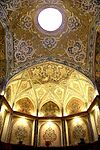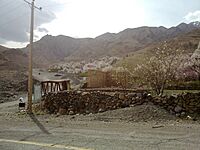Kashan facts for kids
Quick facts for kids
Kashan
کاشان
|
|
|---|---|
|
City
|
|
|
Clockwise from the top:
Borujerdi House, Sultan Amir Ahmad Bathhouse, Tabatabai House, Agha Bozorg Mosque, Fin Garden. |
|
| Country | Iran |
| Province | Isfahan |
| County | Kashan |
| District | Central |
| Population
(2016)
|
|
| • Urban | 304,487 |
| • Metro | 432,557 |
| Time zone | UTC+3:30 (IRST) |
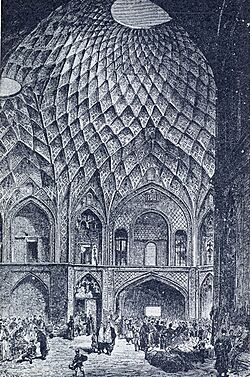
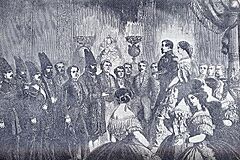
Kashan (Persian: کاشان; [kɒːˈʃɒːn]) is a city in the Central District of Kashan County, in the northern part of Isfahan province, Iran, serving as capital of both the county and the district.
Contents
History
Earliest evidence of human presence around Kashan date back to Paleolithic period that have been found at Niasar, Kaftar Khoun and Sefid-Ab. Middle Paleolithic stone tools were discovered at travertine spring of Niasar and the travertine of Kaftar Khoun. Upper Paleolithic groups were living around Sefid-Ab spring at SW of Kashan.
By some accounts, although not all, Kashan was the origin of the three wise men who followed the star that guided them to Bethlehem to witness the nativity of Jesus, as recounted in the Bible. For example, medieval traveler Friar Odoric of Pordenone related this story in 1330 after having visited there.
According to a legend dating from the Safavid era, Abu Lu'lu'a, the Persian skilled craftsman who was enslaved by the Islamic conquerors and who eventually assassinated the caliph Umar ibn al-Khattab in 644, fled to Kashan after the assassination. The shrine that was built over his supposed tomb is one of Kashan's landmarks (see gallery below).
During the rule of Timurid Empire, Kashan were patronized by Ulugh Beg, grandson of Timur. After the era of Timurid rulers, Kashan then came simultaneously under the rule of Qara Qoyunlu, and then Aq Qoyunlu. Kashan was also a leisure vacation spot for Safavid kings.
The earthquake of 1778 leveled the city of Kashan and all the edifices of Shah Abbas Safavi, leaving 8000 casualties. But the city started afresh.
Demographics
Population
At the time of the 2006 National Census, the city's population was 248,789 in 67,464 households. The following census in 2011 counted 275,325 people in 80,015 households. The 2016 census measured the population of the city as 304,487 people in 91,935 households.
Geography
Kashan is divided into two parts, mountainous and desert.
Location
The city of Kashan is located in the north of Isfahan province, north of the Karkas Mountains and west of Dasht-e Kavir desert, where it is poor in terms of vegetation and where bushes and shrubs are more or less found.
Mountains
Dare mountain is next to Dare village and 14 kilometers southwest of Kashan with a height of 2,985 meters overlooking the city of Kashan, and Gargash peak is the second highest peak of the Karkas mountain range (the first is mount Karakas in Natanz), 33 kilometers southwest of Kashan and 12 kilometers southwest of Qamsar and 7 kilometers northeast of Kamu with a height of 3,600 meters is located near the city of Kamu and Chogan. Kashan has the least light and air pollution. For this reason, it was chosen by international experts as the most appropriate and best place to establish the National Observatory of Iran, and the home of one of the largest large telescopes in the Middle East with the latest technology.
Ardahal peak is located 35 kilometers west of Kashan with a height of 3505 meters after Gargash, is the highest point of Kashan heights (continuation of the central mountain range) in the vicinity of Niaser and the villages Nashlej and Mashhad.
Climate
Kashan has a hot desert climate, with (BWh) designation in Köppen climate classification and (BW) in Trewartha climate classification, with cold winters (although warmer than other Iranian cities) and very hot and dry summers. Kashan is significantly warmer than other cities in the Iranian Plateau due to its lower elevation.
| Climate data for Kashan (1991–2020, records 1966-2020) | |||||||||||||
|---|---|---|---|---|---|---|---|---|---|---|---|---|---|
| Month | Jan | Feb | Mar | Apr | May | Jun | Jul | Aug | Sep | Oct | Nov | Dec | Year |
| Record high °C (°F) | 22.0 (71.6) |
27.0 (80.6) |
36.4 (97.5) |
37.0 (98.6) |
42.0 (107.6) |
48.0 (118.4) |
48.0 (118.4) |
47.1 (116.8) |
43.0 (109.4) |
39.0 (102.2) |
32.2 (90.0) |
24.5 (76.1) |
48.0 (118.4) |
| Mean daily maximum °C (°F) | 10.7 (51.3) |
14.2 (57.6) |
19.9 (67.8) |
26.0 (78.8) |
32.1 (89.8) |
38.1 (100.6) |
40.8 (105.4) |
39.7 (103.5) |
35.1 (95.2) |
27.5 (81.5) |
18.0 (64.4) |
12.2 (54.0) |
26.2 (79.2) |
| Daily mean °C (°F) | 4.9 (40.8) |
8.0 (46.4) |
13.4 (56.1) |
19.3 (66.7) |
25.1 (77.2) |
31.0 (87.8) |
33.7 (92.7) |
32.2 (90.0) |
27.3 (81.1) |
20.1 (68.2) |
11.8 (53.2) |
6.4 (43.5) |
19.4 (67.0) |
| Mean daily minimum °C (°F) | −0.2 (31.6) |
2.1 (35.8) |
6.9 (44.4) |
12.3 (54.1) |
17.4 (63.3) |
22.4 (72.3) |
25.4 (77.7) |
23.6 (74.5) |
18.9 (66.0) |
13.0 (55.4) |
6.1 (43.0) |
1.4 (34.5) |
12.4 (54.4) |
| Record low °C (°F) | −17.4 (0.7) |
−10.0 (14.0) |
−4.5 (23.9) |
0.0 (32.0) |
5.4 (41.7) |
10.6 (51.1) |
15.2 (59.4) |
12.4 (54.3) |
10.0 (50.0) |
4.5 (40.1) |
−8.6 (16.5) |
−8.0 (17.6) |
−17.4 (0.7) |
| Average precipitation mm (inches) | 20.6 (0.81) |
15.1 (0.59) |
26.3 (1.04) |
21.6 (0.85) |
14.0 (0.55) |
1.5 (0.06) |
0.4 (0.02) |
0.5 (0.02) |
0.3 (0.01) |
4.7 (0.19) |
14.6 (0.57) |
14.7 (0.58) |
134.3 (5.29) |
| Average snowfall cm (inches) | 12.2 (4.8) |
3.5 (1.4) |
1.0 (0.4) |
0.0 (0.0) |
0.0 (0.0) |
0.0 (0.0) |
0.0 (0.0) |
0.0 (0.0) |
0.0 (0.0) |
0.0 (0.0) |
0.1 (0.0) |
1.4 (0.6) |
18.2 (7.2) |
| Average precipitation days (≥ 1.0 mm) | 4.1 | 2.8 | 3.8 | 3.5 | 2.1 | 0.5 | 0.2 | 0.1 | 0.2 | 1.2 | 2.7 | 3.1 | 24.3 |
| Average snowy days | 2.7 | 1.2 | 0.5 | 0.0 | 0.0 | 0.0 | 0.0 | 0.0 | 0.0 | 0.0 | 0.1 | 1.0 | 5.5 |
| Average relative humidity (%) | 61 | 52 | 43 | 40 | 33 | 22 | 21 | 22 | 25 | 37 | 53 | 62 | 39 |
| Average dew point °C (°F) | −2.8 (27.0) |
−2.5 (27.5) |
−0.6 (30.9) |
3.4 (38.1) |
5.8 (42.4) |
5.6 (42.1) |
7.0 (44.6) |
6.3 (43.3) |
4.6 (40.3) |
3.6 (38.5) |
1.2 (34.2) |
−1.0 (30.2) |
2.6 (36.6) |
| Mean monthly sunshine hours | 187 | 194 | 222 | 234 | 282 | 329 | 332 | 341 | 306 | 264 | 192 | 176 | 3,059 |
| Source 1: NCEI(snowfall 1981-2010) | |||||||||||||
| Source 2: IRIMO(snow days and extremes 1966-2010)[1] | |||||||||||||
Main sights
On August 9, 2007, Iran placed the Historical Axis of Fin, Sialk, Kashan on its Tentative List for possible future nomination as a UNESCO World Heritage Site. The exact definition of what locations within Kashan proper might be nominated was not made clear. In 2012 Iran successfully nominated the Fin Garden separately for inscription by UNESCO as a part of its Persian Gardens World Heritage Site. Despite this the "Historical-Cultural Axis of Fin, Sialk, Kashan" remains in full on Iran's Tentative List. The Boroujerdiha house is one of the historical places from the Qajar period.
Kashan's architectural sights include:
- Abbāsi House
- Agha Bozorg Mosque
- Āmeri House
- Bazaar of Kashan
- Boroujerdi House
- Fin Garden
- Jalali Castle
- Jameh Mosque of Kashan
- Meydan Mosque
- Shrine of Abu Lu'lu'a (shrine dedicated to the assassin of Umar, the second Islamic caliph)
- Sultan Amir Ahmad Bathhouse
- Tabātabāei House
- Tabriziha Mosque
- Tepe Sialk
Today
Kashan is known for the manufacture of carpets, silk and other textiles.
Education
There are more than 10,000 students currently studying in various fields (e.g.:Applied sciences, Engineering, Art, Law, Medical sciences, Nano technology, literature, Carpet and Handicrafts, etc.) at universities of Kashan. Colleges and universities in Kashan include:
- Kashan University of Medical Sciences
- Islamic Azad University of Kashan
- University of Kashan
Accessibility
- Road 71
- Freeway 7, located near the city
Kashan is connected via freeways to Isfahan and Natanz to the South, and Qom, which is an hour drive away to the north. Kashan railway station is along the main north–south railways of Iran. Kashan Airport reopened on 2 June 2016 after twenty years hiatus with an ATA Airlines flight from Mashhad International Airport.
Notable people
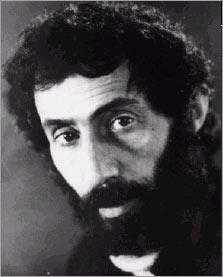
- David Alliance, Baron Alliance
- Ghyath ad-Din Jamshid Kashani
- Kamal-ol-Molk
- Amir Ghafour
- Ehsan Hajsafi
- Javad Kazemian
- Mohsen Feyz Kashani
- Sohrab Sepehri
- Ustad Ali Maryam
- Afdal al-Din Kashani
- Reza Abbasi
- Sani ol molk
- Kalim Kashani
- Muhtasham Kashani
- Ghotb Ravandi
- Saeed Hajjarian
- Mohammad Motamedi
- Mulla Muhammad Mahdi Naraqi
- Molla Fathollah Kashani
- Sani ol molk
- Moluk Zarabi
- Pari Zangeneh
Twin towns – sister cities
Gallery
See also
 In Spanish: Kashan para niños
In Spanish: Kashan para niños







